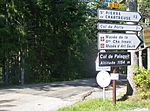The Néron is a mountain in the French department of Isère at 1,299 metres in the Chartreuse massif in the Alps. Sometimes called Casque du Néron in the 19th century because of its shape, its name literally means "the black one" and has no connection with the Roman emperor or with the existence of an ancient station used as a lookout and refuge in its southern part. The mountain is shaped like an inverted ship's hull with a very pronounced north–south oriented main ridge and is mainly composed of Urgonian limestone. Due to its exposure, it has a Mediterranean flora, although this has been weakened by the fire in the summer of 2003, which destroyed the entire upper part of the mountain. The mountain is also part of the Chartreuse regional nature park.
The southern end of the Néron is occupied by a cave called Balme de l'Hermitage. The site, occupied since the Neolithic period, was home to a luxurious villa from the Middle Ages onwards, transformed into a castle, which passed in turn into the hands of rich families and religious orders. At that time, the forests on the mountain slopes were intensively exploited to supply charcoal to the foundries and were largely replaced by vineyards. Thus, in the 19th century, the first scientific and military explorers used some of the steep paths made by the loggers. The Néron appeared in Joanne Guides, but the number of victims increased rapidly and it acquired a bad reputation. The first complete crossing from north to south was carried out in 1884 in order to evaluate the possibility of establishing military batteries on the summit of the mountain. Finally, the construction of a road was started in 1891 to lead to the location of the batteries, which were completed two years later to the north of the mountain, upstream of the Vence gorges. At the same time, exploration of the Néron led to the discovery of the ancient Roman pathway and the remains of the ten-metre long ancient footbridge in the south-eastern escarpments. Subsequently, a series of archaeological excavations led by Hippolyte Müller uncovered the cistern of the former lookout and a number of artefacts. New accidents led to the creation of the Dauphinois mountain rescue committee, the beaconing of trails, the laying of cables, and, in 1911, the inauguration of a new footbridge. The Roman path became the main route of the Néron, replacing the unstable corridors of the eastern face and the steep paths of the western slope. The Boujard inn, in the hamlet of l'Hermitage, flourished in the first half of the 20th century. However, the château de la Balme was burnt down in 1932 and abandoned for good. After the Second World War, with the exception of the opening of a few climbing routes around the 1970s and the chronicles generated by a work representing Lucky Luke on one of the summits overlooking the Grenoble area, the Néron lost much of its appeal; municipal by-laws regularly forbade access to it because of rock falls and the dropping of most of the paths.












